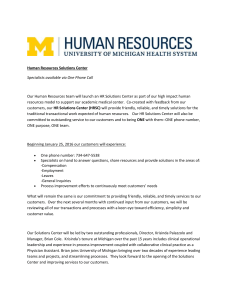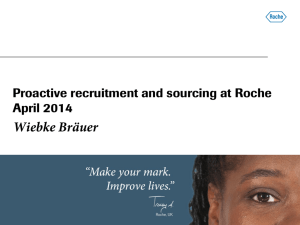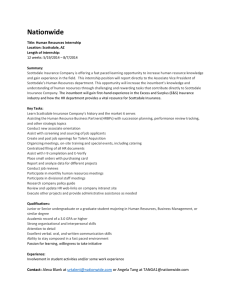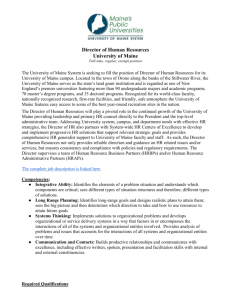Human Rights Best Practices in Schools: SUHAKAM Program
advertisement
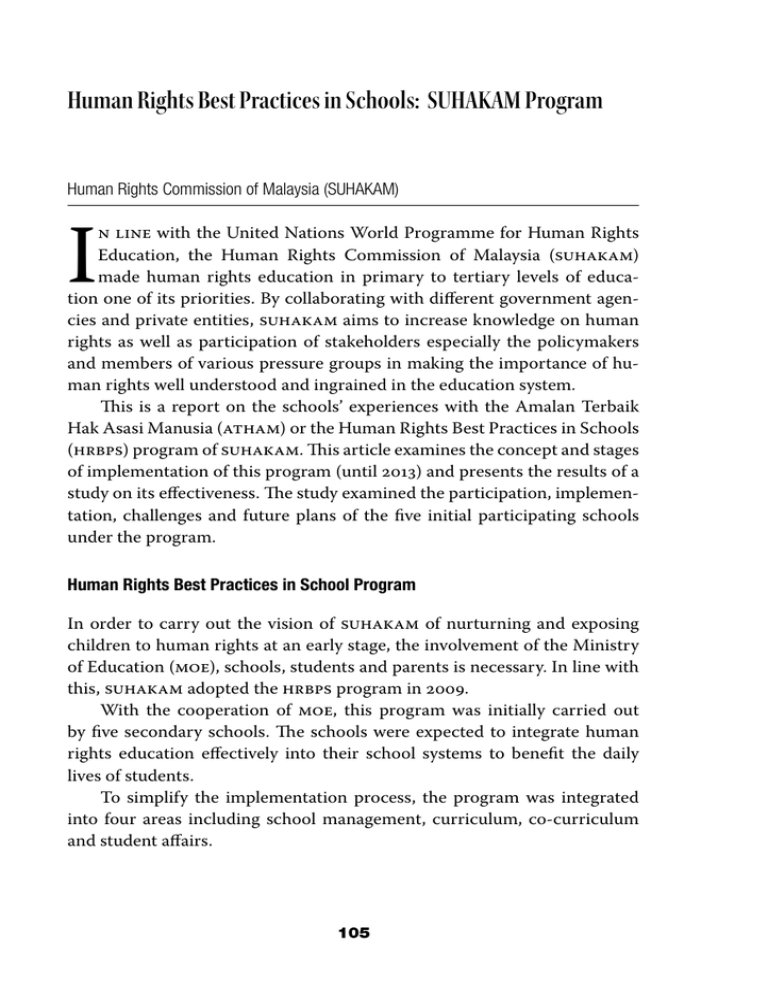
Human Rights Best Practices in Schools: SUHAKAM Program Human Rights Commission of Malaysia (SUHAKAM) I n line with the United Nations World Programme for Human Rights Education, the Human Rights Commission of Malaysia (suhakam) made human rights education in primary to tertiary levels of education one of its priorities. By collaborating with different government agencies and private entities, suhakam aims to increase knowledge on human rights as well as participation of stakeholders especially the policymakers and members of various pressure groups in making the importance of human rights well understood and ingrained in the education system. This is a report on the schools’ experiences with the Amalan Terbaik Hak Asasi Manusia (atham) or the Human Rights Best Practices in Schools (hrbps) program of suhakam. This article examines the concept and stages of implementation of this program (until 2013) and presents the results of a study on its effectiveness. The study examined the participation, implementation, challenges and future plans of the five initial participating schools under the program. Human Rights Best Practices in School Program In order to carry out the vision of suhakam of nurturning and exposing children to human rights at an early stage, the involvement of the Ministry of Education (moe), schools, students and parents is necessary. In line with this, suhakam adopted the hrbps program in 2009. With the cooperation of moe, this program was initially carried out by five secondary schools. The schools were expected to integrate human rights education effectively into their school systems to benefit the daily lives of students. To simplify the implementation process, the program was integrated into four areas including school management, curriculum, co-curriculum and student affairs. 105 106 H u m a n R i g h t s E d u c at i o n i n A s i a - Pa c i f i c Objectives of the Program The hrbps program has the following objectives: i. To encourage students and members of the school to be attentive and take necessary steps to practice human rights; ii. To develop a culture of respect and responsibility in relation to human rights and to practice this culture on a daily basis; iii. To increase understanding on human rights for the benefit of everyone; iv. To encourage students and teachers to pay attention to human rights aspects when planning and carrying out activities at school; v. To share experiences about human rights practice in school and the local community; and vi. To strengthen the relationship between students regardless of race, religion or gender. Participation and Activities The program started in 2009 with five secondary schools in the states of Selangor, Perak, Negeri Sembilan and Malacca. Later in 2011 the number increased to seventeen primary, secondary, rural and interior schools. In 2013, based on the success of the program, the moe decided to include a further one hundred twenty-three schools into the program, or at least one school in every district in Malaysia. Realizing that the current education system may be overburdened with the creation of new projects, involvement in the program was either through new projects or existing activities that are strengthened and expanded to include human rights elements. School projects must include the following components: a. Provide human rights awareness to students; b. Strengthen ties and improve interaction among students regardless of race, religion or gender; c. Develop and increase knowledge of human rights and child rights through the activities being carried out; d. Develop a school culture which practices and values human rights; and e. Set an example for other schools to follow. Human Rights Best Practices in Schools: SUHAKAM Program 107 The participating schools decide on the projects they would implement under the hrbps program. Each participating school must refer to human rights materials including the Universal Declaration of Human Rights (udhr), Convention on Rights of the Child (crc) and other documents deemed appropriate by the school. The Human Rights-Friendly Schools Project Suhakam supports school projects that adhere to the objectives of the hrbps program. It promotes, for example, the human rights-friendly school concept and the whole school approach as bases of school projects. The Human Rights-Friendly Schools project seeks: a. To promote the whole-school approach in the integration of human rights into the school system; b. To demonstrate that the approach is valid and effective globally and to create replicable models which will act as an inspiration to other schools and as a form of advocacy to governments. Many schools that adopt the whole-school approach to human rights take as their foundational text either the undhr or the crc. Secondary schools may find it more appropriate to take the Universal Declaration of Human Rights as their foundational text, since some of their students may no longer be children in the legal sense (under the age of eighteen years); many students of secondary-school age are aspiring adults. What is the ‘whole-school approach’ to human rights? A “human rights-friendly” school is a school that supports human rights. It entails the creation of an environment and a community in which human rights are taught, learned, practised, respected and promoted. This means ensuring that human rights are present in all major areas of school life. The goal of the whole-school approach is to create a rights-respecting school environment, with members of school communities who are knowledgeable about and dedicated to the promotion of human rights, and with individuals who have not only the knowledge but also the values, skills and experience as effective activists on human rights issues. In short, it promotes a culture of human rights. For purposes of the project, the major ar- 108 H u m a n R i g h t s E d u c at i o n i n A s i a - Pa c i f i c eas of school life into which human rights should be integrated under the whole school approach are: a. Curriculum; b. Extracurricular activities and school environment; c. School governance; d. Student affairs. In the curriculum, human rights are incorporated into themes, issues, perspectives and approaches in existing subjects and units. Subjects and units found to be particularly appropriate to human rights discussion are social sciences courses such as History, Economics, Geography, Literature, Languages, Arts, Civics and Citizenship. In the extracurricular areas and school environment, schools often have more freedom and flexibility in developing activities than in integrating human rights into the school curriculum. Extracurricular activities can include establishment of human rights club; organizing of festivals (human rights festival, human rights film festival, human rights visual and dramatic arts festival); holding of commemorations or other events to mark specific international or national days related to human rights; campaigns against bullying, harassment or violence in the school or the wider community; development of safe-school program; undertaking child-friendly school activities, adoption of social service program with human rights focus for the surrounding community; and implementation of training program for students on campaigning and activism. The list is endless. The goal is not to do them all but to devise a realistic strategy of integrating human rights into areas of the school system. In school governance, a chief concern is that not all stakeholders in the school community have a say in the decision-making process. In this area, opportunities can often be found in reviewing ways of managing the school with the support of the parent-teachers association or how school meetings are conducted. These activities can often provide opportunities to cultivate a culture of trust, respect and shared responsibility in the school community. Another area under the heading of school governance is the school policies on inclusion and integration, equality, diversity, anti-racism, antibullying, recruitment, enrolment, poverty and the disadvantaged, gender, the environment and healthy eating, and other issues. Human Rights Best Practices in Schools: SUHAKAM Program 109 In student affairs, quite often the key question is how to promote an atmosphere of respect and tolerance. A concrete measure is to make school and class charters or code of conduct through a participatory process so that all feel bound by a document that they helped make. An important aspect to consider here is how matters of discipline are to be addressed. Again, the ideal is that both staff and students agree on the rules and feel equally responsible for upholding them. In a human rights context, the ideal form of discipline is self-discipline, and a key means of promoting that is involving all community members in creating the rules by which they have to abide. HRBPS Program Implementation Phases The hrbps program is implemented in several phases as shown in Table 1. Table 1. Program Implementation Phases Phase Objective Activity Phase 1 Program introduction Workshop to explain the project to the school Principals and Coordinators Phase 2 Monitoring Planning and consultation at the school level Phase 3 Monitoring Guidance and consultation Phase 4 Evaluation Assessment of projects in all the schools Study of HRBPS Program Implementation To support the development of the program, suhakam commissioned Sultan Idris Education University (upsi) to conduct a scientific study on the effectiveness of the program. The study started in May 2011 and was completed in October 2011. It used a mixed-method sequential exploratory design (Creswell, 2009) in soliciting qualitative and quantitative data. Both the qualitative and quantitative phases were connected sequentially as the items in the questionnaires were mainly based on the qualitative results collected at the first phase of the study. In the qualitative research method, one hundred three respondents comprising of principals, senior assistants, hrbps coordinators, as well as teachers and students, both involved and not involved in the planning and implementation of the hrbps program, were interviewed using a semi- 110 H u m a n R i g h t s E d u c at i o n i n A s i a - Pa c i f i c structured interview protocols. Observations and documents were also analyzed during the qualitative data collection. In the quantitative research method, seven hundred ninety-eight respondents, namely one hundred forty eight teachers (including school principals, senior assistants) and six hundred fifty students participated in the survey, using questionnaires. It should be noted that not all respondents who were interviewed responded to the questionnaires and that majority of the respondents (namely the teachers and the students) in the questionnaires were not involved in the planning and implementation of the hrbps program. Nonetheless their views, together with those who were involved in the hrbps program, are relevant in providing useful information on the school experiences with the hrbps program, and the future directions of the hrbps program in creating a culture of human rights practices in the school system on long-term basis. The qualitative data were analyzed and categorized for common themes while the quantitative data were analyzed using the spss software. The qualitative and quantitative data were then consolidated. StrengthWeakness-Opportunities-Threats (swot) analysis was used to summarize the strengths, weaknesses, opportunities and threats of the program, and a Best Known Model (bkm) on the hrbps program in Malaysian schools was proposed. For purpose of confidentiality, the names of the five schools are not mentioned in this report. Summary of Findings and Recommendations Experiences with the hrbps program as perceived by the teachers and students in the five schools were collectively summarized in an attempt to formulate recommendations for the development of the program. Their views were expressed in terms of the importance of the hrbps program objectives, participation, school’s intention on the program, challenges of the program, ways to overcome the challenges, ways in implementing the program, benefits, future plans of the program, and human rights education practices in other countries. It must be stressed that the recommendations in this study have taken into consideration the limitations of the study and the possibility of the hrbps program being implemented in settings with similar local context. Human Rights Best Practices in Schools: SUHAKAM Program 111 Findings The study has the following findings: 1. Most teachers, school administrators (principals and senior assistants), and the students agreed that all the hrbps objectives were important. However, they indicated greater preference to instilling the importance of mutual respect, and strengthening relationship and interaction among students regardless of their race, religion and gender compared to the other hrbps objectives. As to the hrbps objectives on the integration of human rights practices, they showed greater preference to the integration of the program in the co-curriculum activities and school environment compared to integration in the class sessions and the local community. As both the teachers and the students generally agreed that all the hrbps objectives were important, it is recommended that all the hrbps objectives be retained. 2. The study found gaps in the dissemination of information on the hrbps program to the schools prior to their participation, and to all the teachers and the students in the participating schools. The study indicated that the teachers’ main sources of information on human rights and the hrbps program were the local media and the internet, while the students’ main source of information was their teachers. It was also observed that the information on the program were displayed in school bulletin boards or specially assigned areas in the school compound. In this context, it is recommended that more information and publicity on the hrbps program be provided via the local media and internet to all schools and teachers, and that more information on human rights continue to be displayed in bulletin boards, along the school corridor, and in specially assigned locations in the school compound. 3. As the schools, particularly the school principals, agreed to participate in the program, the strong support and commitment by the school principals were important in ensuring the implementation of the hrbps program in the schools. The important leadership role by the principals in all the schools indicated that the program was implemented as planned. In this regard, it is recommended that the principals continue to play active and leading role in disseminat- 112 H u m a n R i g h t s E d u c at i o n i n A s i a - Pa c i f i c ing information on the hrbps program and human rights to all the teachers and the students and at the same time be role models in human rights practices in their schools. The teachers perceived that the hrbps program could be integrated into the school curriculum and co-curricular activities to improve student behavior, particularly discipline, and the school environment while the students perceived that the integration should be through a human rights education subject. Both the teachers and the students agreed that human rights could be integrated in the existing curriculum, co-curriculum activities and school environment. It is acknowledged that all the schools practice human rights through the existing curriculum, co-curriculum, and school environment prior to their participation in the hrbps program. However, all the schools prior to their participation in the hrbps program did not overtly implement current practices that subscribe to the udhr and the crc principles. In this context, it is recommended that the whole-school approach practices that subscribe to the udhr and crc principles be overtly adopted by schools in the curriculum (in the school subjects), co-curriculum and school environment. It is further recommended that human rights education specifically on the udhr and crc be directly integrated across all the school subjects and the school environment. 4. As it was acknowledged by the schools that a lot of improvement could be done to increase human rights awareness in the school if all the different stakeholders worked together, it is further recommended that all stakeholders, both internal and external, cooperate and collaborate to improve human rights conditions in the schools. 5. In implementing the hrbps program, the schools conducted special hrbps activities or projects with the support of suhakam. Although the respondents seemed to have neutral response regarding special activities in implementing the hrbps program, they acknowledged that these specific hrbps activities had increased their awareness and knowledge on human rights as well as their responsibilities in human rights practices. Since the schools are at the stage of familiarizing themselves with human rights while trying to integrate human rights in their school systems based on the udhr Human Rights Best Practices in Schools: SUHAKAM Program 113 and the crc principles, it is recommended that special hrbps activities or projects be continued. Such purposeful and value-added projects that subscribe to the udhr and crc principles have not only created greater awareness and knowledge on human rights, but have benefited both the teachers and the students. It is hoped that the good human rights practices be entrenched in the schools on a long-term basis. 6. The findings also indicated that the teachers and the students who were directly involved in the planning and implementation of the hrbps program activities seemed to have benefited more than the teachers and the students who were not directly involved in the program. This is explained by the responsibilities given to the former to lead in election of prefects, and organize co-curricular and special activities on the hrbps program. Most of the teachers and the students seemed to have neutral responses to the question about the hrbps program being a burden to their daily tasks and responsibilities in the school. In this context, it is recommended that the schools increase the number of teachers and students in the planning and implementation of the hrbps program and encourage all teachers and students to practise human rights in their daily tasks and responsibilities. 7. The teachers and the students perceived that the most agreeable method in overcoming the barriers to the implementation of the hrbps program is the involvement of all school stakeholders, namely, students, teachers and administrators, in program implementation. On this basis, it is recommended that every effort be made by the school authorities to promote a culture of human rights to all teachers and students in their relationship among themselves and to others on daily basis. 8. The teachers and the students were of the opinion that there was a lack of integration of human rights in the class sessions that could impede the whole-school approach in the integration of human rights in the schools. In this context, it is recommended that good human rights practices be given due consideration inside the classroom. Since the schools implemented the hrbps program outside the classroom and also due to the time constraint, the study was not able to include classroom observation regarding human rights 114 H u m a n R i g h t s E d u c at i o n i n A s i a - Pa c i f i c practices in the class. In overcoming this limitation of the study, it is further recommended that a research study be conducted to identify the issues and problems in integrating human rights in the class environment. 9. Several constraints or weaknesses in the hrbps program implementation were identified, namely, the time factor, the lack of knowledge and skills on imparting human rights among teachers and students, and the lack of support and commitment of all teachers and students in implementing the program. However, the teachers and the students were agreeable in collaborating with suhakam, local communities and non-governmental organizations (ngos) to promote human rights in their schools. In addition, they agreed that the practices of human rights education in other countries were important to Malaysia as well. In acknowledging that such constraints could be barriers to successful implementation of the program, it is recommended that the teachers and the students be given more knowledge and skills on human rights as well as opportunities to work in collaboration with various agencies, such as suhakam, local communities, and ngos pertaining to avocation of human rights. Workshops, seminars, and in-house training on human rights, particularly pertaining to the udhr and crc, can be conducted by various agencies for the school principals and administrators, teachers and students. In addition, human rights education practices in other countries should be made available to provide ideas and lessons on the implementation of hrbps program in Malaysian schools. 10. The best known model (bkm) on the hrbps program needs to take into consideration the experiences of the schools that participated in the program, specifically in relation to the program’s strengths, weaknesses, opportunities and threats (swot). The schools acknowledged that the direct involvement of suhakam at the school level ensured that the program was successfully implemented in the schools. In this regard, it is recommended that suhakam continues its collaboration and direct involvement in program implementation at school level until such time when the schools have gained confidence to do on their own the integration of human rights practices in their school systems. Human Rights Best Practices in Schools: SUHAKAM Program 115 11. Although the results indicated initial apprehension on the part of the teachers about the hrbps program as “extra burden” and “stressful,” both the teachers and the students perceived that the program might not be a burden to their daily tasks and responsibilities. Furthermore, they acknowledged that the program was important and should be implemented immediately by all and in all schools. There was also a suggestion that a special hrbps unit be set up at the department of education at either state or district level to have one common or consensus hrbps program for all. Such a suggestion would perhaps ensure that the schools could depend on the relevant authorities for support and commitment on long-term basis in establishing a culture of human rights in the schools. It is thus recommended that due to the importance of implementing the hrbps program by all and in all schools, a special hrbps unit be set up by the state education department or district education office to support the development of a culture of human rights in the schools on long-term basis. Conclusions of the Study In conclusion, the study suggests that the best known model (bkm) for the hrbps program should be the whole-school approach or holistic integration of human rights in the existing school system. This is in line with the objectives of the hrbps program. Good human rights practices can be integrated in the curriculum, co-curricular activities, policies on students’ behavior and discipline, provisions of learning facilities and services, and learning environment. Since the schools still needed to become familiar with human rights while trying to integrate human rights in their schools based on the udhr and crc principles, it is recommended that special hrbps activities or projects be continued. Suhakam’s continuing collaboration and direct involvement in the program would still be needed until such time when schools are confident in integrating human rights practices on daily basis in the school system. The suggestion that the Ministry of Education give serious consideration to the setting up of a special unit at the department of education at either state or district level in order to have a common hrbps program for all would ensure that the schools can depend on the relevant authorities for support and 116 H u m a n R i g h t s E d u c at i o n i n A s i a - Pa c i f i c commitment on long-term basis in establishing a culture of human rights in the schools. In sum, drawing from the findings in this study, the Best Known Model (bkm) on the hrbps program is one on holistic integration of human rights in the existing curriculum, co-curricular activities, school discipline and learning environment. This whole-school approach in human rights practices in the schools should be overtly implemented as intended in the hrbps program. Conclusion The hrbps program was well received by the participating schools. It has helped many schools in handling problems such as truancy, poor academic results and problems on discipline. In short, the whole-school approach of suhakam’s hrbps program and the United Nations World Programme for Human Rights Education seemed to be acceptable by the schools in Malaysia. This program is still at its infant stage and suhakam would push harder for the implementation of the program in every school in Malaysia in pursuit of its aim of nurturing knowledge and practice on human rights at the early stage of children’s development. Reference Creswell, John W. 2009. Research Design: Qualitative, Quantitative, and Mixed Methods Approaches (3rd ed.). Los Angeles: Sage Publications, Inc.
